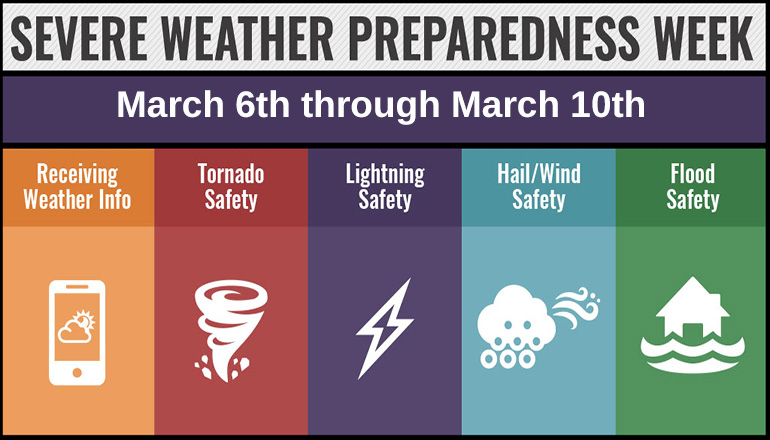Flood Preparedness: Key Actions For Severe Weather Awareness Week Day 5

Table of Contents
Assessing Your Flood Risk
Understanding your vulnerability is the first step in effective flood preparedness. This involves identifying potential flood sources and determining your property's risk level.
Understanding Your Location
Knowing if your home sits in a flood plain or a flash flood-prone area is crucial. Utilize available resources to accurately assess your risk:
- Use online tools: The Federal Emergency Management Agency (FEMA) provides online flood maps where you can enter your address to check your flood risk. Many local government websites also offer similar tools.
- Contact your local emergency management agency: They possess detailed local information about flood history and high-risk areas, offering tailored advice for your specific location. This is invaluable for hyperlocal flood preparedness.
- Consider past flooding history: Research past flood events in your area. Local news archives, historical records, and community discussions can reveal valuable insights into flood patterns and severity.
Identifying Potential Flood Sources
Recognizing potential flood sources near your property is vital for effective flood preparedness. Consider these factors:
- Rivers and streams: Proximity to overflowing rivers or streams significantly increases your flood risk. Monitor their water levels during heavy rainfall.
- Drainage systems: Clogged or inadequate drainage systems can cause localized flooding, even in areas not traditionally considered high-risk.
- Poor drainage: Areas with poor drainage, such as low-lying land or areas with compacted soil, are more susceptible to water accumulation during heavy rainfall.
- Upstream developments: Construction or development upstream can alter water flow and increase your flood risk. Be aware of changes in your area.
- Rising water tables: High water tables can exacerbate flooding, especially in areas with poor drainage.
Developing a Flood Preparedness Plan
A comprehensive plan is essential for effective flood preparedness. This plan should cover communication, emergency supplies, and protective measures.
Creating a Family Communication Plan
Establishing a clear communication plan is crucial, particularly if family members are separated during a flood:
- Designate an out-of-area contact: Choose someone outside your immediate area who can serve as a central contact point for family members to check in.
- Establish a meeting point: Identify a safe, easily accessible meeting point in case of separation.
- Create an evacuation plan: Develop a detailed plan for evacuating your home, including routes and transportation options.
- Practice your plan: Regularly practice your communication and evacuation plans to ensure everyone knows what to do in an emergency.
Building an Emergency Kit
Having a well-stocked emergency kit is a cornerstone of effective flood preparedness. Your kit should include:
- Water: Store at least one gallon of water per person per day for several days.
- Non-perishable food: Include easy-to-prepare, non-perishable food items.
- Medications: Keep a supply of essential medications.
- Flashlights and battery-powered radio: Ensure you have reliable sources of light and information during a power outage.
- First-aid supplies: Include a well-stocked first-aid kit.
- Important documents: Store vital documents, such as insurance policies and identification, in a waterproof container.
- Extra clothing and blankets: Pack extra warm clothing and blankets for protection against cold temperatures.
- Pet supplies: If you have pets, include pet food, water, and any necessary medications.
Elevating Valuable Items
Protecting your valuables from flood damage is a key aspect of flood preparedness:
- Move valuable items to higher levels: Relocate important documents, electronics, and other irreplaceable items to higher floors or shelves.
- Use waterproof containers: Store sensitive items in waterproof containers or bags.
- Protect appliances: Take steps to protect appliances from potential water damage.
- Back up important data: Regularly back up important digital data to cloud storage or an external hard drive.
Taking Protective Actions Before, During, and After a Flood
Proactive measures before, during, and after a flood are vital for minimizing damage and ensuring safety.
Before a Flood Warning
Taking preventative actions before a flood warning significantly improves your flood preparedness:
- Clear gutters and drains: Ensure that gutters and drains around your home are clear to prevent water buildup.
- Secure loose items: Bring in outdoor furniture and secure any loose items that could be carried away by floodwaters.
- Monitor weather forecasts: Closely monitor weather forecasts and flood warnings issued by local authorities.
- Prepare your vehicle: Ensure your vehicle is fueled and ready for a potential evacuation.
- Consider flood insurance: Purchasing flood insurance can provide crucial financial protection in the event of a flood.
During a Flood
Your actions during a flood are critical for your safety. Prioritize evacuation if instructed:
- Evacuate if instructed: If advised to evacuate by authorities, do so immediately and without delay.
- Never drive or walk through floodwaters: Floodwaters can be deceptively deep and swift, posing significant risks.
- Turn off utilities: If instructed by authorities, turn off gas, electricity, and water to prevent further damage.
- Move to higher ground: If it's safe to do so, move to higher ground.
- Stay informed: Stay informed about the flood situation through official sources, such as local news and emergency management agencies.
After a Flood
Post-flood actions are important for recovery and safety. Remember:
- Avoid floodwaters: Floodwaters may be contaminated with sewage and other harmful substances.
- Contact your insurance company: Contact your insurance company to report damages and begin the claims process.
- Inspect your home: Carefully inspect your home for structural damage.
- Dispose of contaminated materials: Properly dispose of any contaminated materials, following local guidelines.
- Document damages: Document all damages with photos and videos for insurance purposes.
Conclusion
This Severe Weather Awareness Week, prioritizing flood preparedness is crucial. By assessing your risk, developing a comprehensive plan, and taking proactive steps before, during, and after a flood, you significantly improve your safety and minimize potential damage. Remember, being prepared for floods is an investment in your family's well-being. Take action today to enhance your flood preparedness and protect your home and loved ones. Learn more about enhancing your flood preparedness strategies by visiting your local emergency management agency website.

Featured Posts
-
 Gaza Captives Ex Israeli Women Soldiers Demand For Release
May 26, 2025
Gaza Captives Ex Israeli Women Soldiers Demand For Release
May 26, 2025 -
 Kemenangan Sprint Race Marquez Di Argentina 2025 Analisis Klasemen Moto Gp
May 26, 2025
Kemenangan Sprint Race Marquez Di Argentina 2025 Analisis Klasemen Moto Gp
May 26, 2025 -
 Jadwal Lengkap Moto Gp Inggris 2024 Sesi Kualifikasi And Balapan
May 26, 2025
Jadwal Lengkap Moto Gp Inggris 2024 Sesi Kualifikasi And Balapan
May 26, 2025 -
 Mynamynw Ybqa Me Mwnakw Tfasyl Altmdyd Aljdyd
May 26, 2025
Mynamynw Ybqa Me Mwnakw Tfasyl Altmdyd Aljdyd
May 26, 2025 -
 Tadej Pogacars Second Tour Of Flanders Win Denying Van Der Poel A Record
May 26, 2025
Tadej Pogacars Second Tour Of Flanders Win Denying Van Der Poel A Record
May 26, 2025
Latest Posts
-
 Bond Market Instability Understanding The Current Crisis
May 28, 2025
Bond Market Instability Understanding The Current Crisis
May 28, 2025 -
 Bethlehem Local Elections Scrutiny Of Candidate Mailers
May 28, 2025
Bethlehem Local Elections Scrutiny Of Candidate Mailers
May 28, 2025 -
 The Bond Markets Hidden Danger A Growing Crisis
May 28, 2025
The Bond Markets Hidden Danger A Growing Crisis
May 28, 2025 -
 Ignoring The Bond Crisis The Risks Investors Face
May 28, 2025
Ignoring The Bond Crisis The Risks Investors Face
May 28, 2025 -
 Justin Baldoni Vs Ryan Reynolds Lawsuit Update And Next Steps
May 28, 2025
Justin Baldoni Vs Ryan Reynolds Lawsuit Update And Next Steps
May 28, 2025
